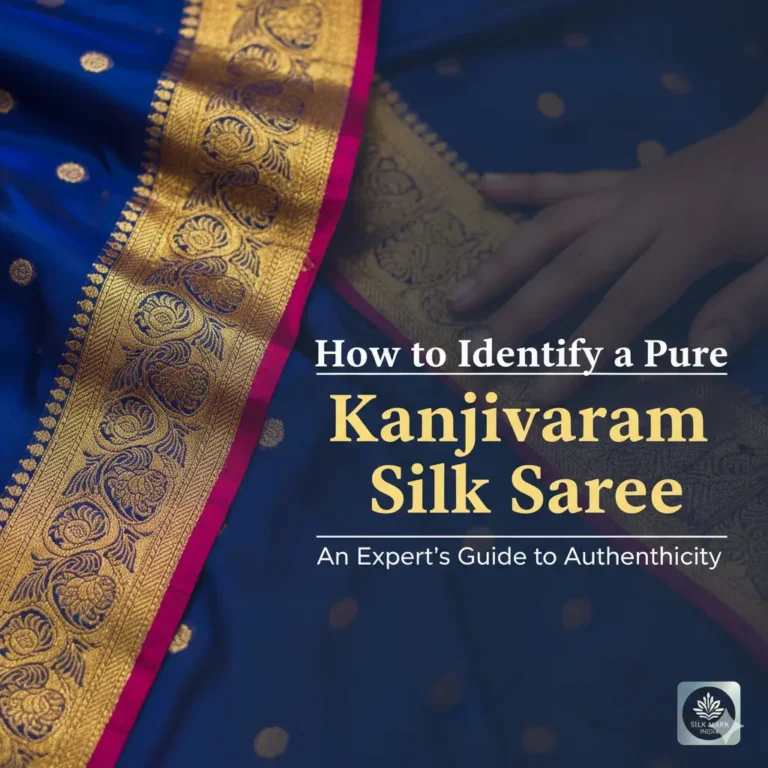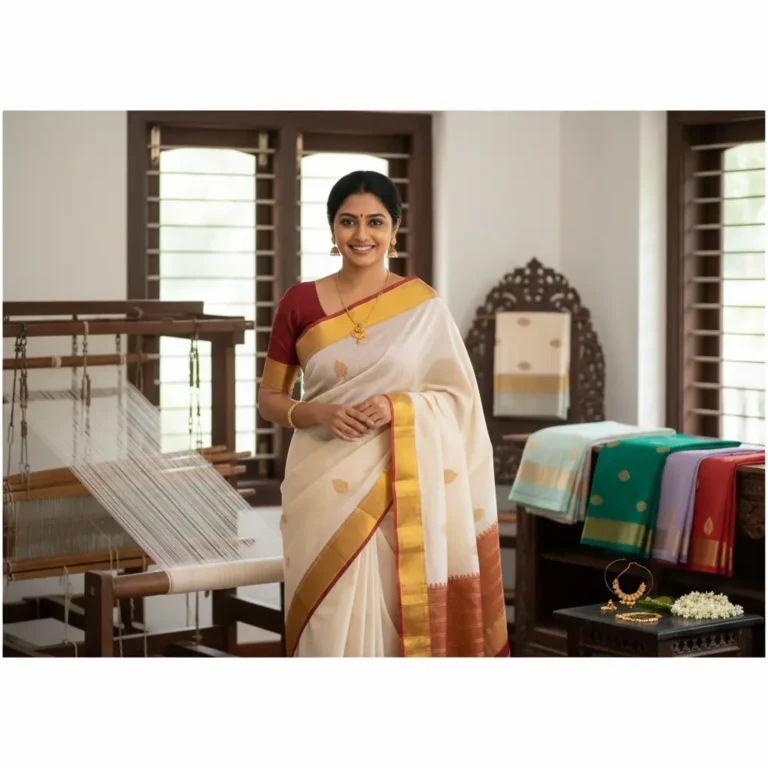A gharchola saree is one of the most cherished pieces of bridal clothing in Gujarat and Rajasthan. Brides wear it during wedding rituals as a symbol of purity, prosperity and love. Its striking grid pattern, Bandhani work and luxurious silk base make it a timeless choice. Yet, because of its popularity, many duplicate and machine-made versions are now flooding the market.
Therefore, buyers need a clear and trustworthy guide to identify an original piece. This complete manual simplifies the process and helps you confidently choose the right gharchola saree for wedding ceremonies, engagements, or festive traditions. In this article, you will learn about the saree’s history, fabric, motifs, authenticity tests, pricing and step-by-step verification.
The Rich History Behind the Gharchola Saree
The gharchola saree history begins in the culturally rich regions of Kutch, Jamnagar and Porbandar. These places have been home to some of India’s finest weavers for centuries. Families from communities like the Khatri, Maheshwari and artisan groups in Mandvi, Khavda and Bhuj have practiced Bandhani and handloom weaving for generations.
Traditionally, a gharchola was gifted to a bride as she entered her new home or “ghar.” This sacred piece symbolized blessings, prosperity and the family’s affection. In Jamnagar, natural dyes like turmeric and madder root were used to achieve deep red and green hues. Meanwhile, Kutch artisans introduced the signature grid pattern and Bandhani dots that now define the saree.
As a result, the gharchola evolved into a powerful symbol of culture, identity and marriage rituals. Today, its legacy continues to be preserved by skilled weavers who pass these techniques down to the next generation.
The Four Pillars of Authenticity: Identifying the Fabric and Weave
The biggest challenge for most buyers is differentiating an authentic gharchola from a synthetic or machine-made one. Original pieces are entirely handcrafted. The silk must be real, the Bandhani must be hand-tied and the zari must be pure.
Below is a detailed breakdown to help you evaluate fabric, weaving, zari and craftsmanship.
Decoding the Silk Base: Patola vs. Gaji
Gaji Silk: Traditional and Accessible
Gaji silk is one of the most common bases used in gharchola sarees. It has a smooth texture and a soft glow that makes it ideal for weddings and festive wear. When you touch real Gaji silk, you will notice that it warms up quickly. This is a classic sign of natural silk.
Furthermore, Gaji gharcholas are more affordable because the dyeing process is simpler. The fabric feels rich, drapes beautifully and lasts for years when maintained properly.
Patola Silk: The Royal Masterpiece
Patola silk is rare, expensive and highly respected. Authentic Patola gharcholas use the ancient ikat technique, originating from the Salvi weaving families of Patan.
There are two major types:
Single-Ikat Patola
Only the warp or weft threads are tie-dyed. It takes weeks to craft and is more affordable than the classic double-ikat.
Double-Ikat Patola
Both warp and weft threads are tie-dyed before weaving. This process can take months due to its complexity. The design matches perfectly on both sides, proving the saree’s authenticity.
Because of this exceptional skill, Patola gharcholas command premium prices and are highly sought-after for royal weddings.
ALSO Read: How to Identify a Pure Kanjivaram Silk Saree
The Signature Weave: Bandhani and Geometric Grids
Hand-tied Bandhani is one of the strongest markers of originality. Skilled artisans tie thousands of tiny knots by hand, creating delicate white dots inside the gharchola’s squares.
Look carefully at the dots:
- Hand-tied Bandhani has slight irregularities.
- Machine prints look too perfect and uniform.
Additionally, the grid pattern is woven—not printed. The squares are usually symmetrical, but minor inconsistencies indicate that the saree is handmade.
The Vows of Color: Traditional Palettes and Motifs
Original gharchola sarees follow classic color combinations, such as:
- Red and green
- Red and yellow
- Red and white
- Maroon and gold
These shades represent auspiciousness and purity in Indian wedding traditions.
But beyond color, motifs also play a huge role in identifying authenticity.
Peacock Motif (Mor)
Symbolizes beauty, grace and prosperity. It brings luck to the bride.
Elephant Motif (Haathi)
Represents strength, royalty and wisdom. It signifies dignity and stability.
Lotus Motif (Kamal)
Stands for purity, rebirth and spiritual growth—perfect for new beginnings.
Kalash and Human Figures
Used in ceremonial gharcholas, these motifs represent abundance and blessings.
Each motif communicates meaning, making the saree not just a garment but a cultural symbol.

Understanding Rajwadi Gharchola Sarees: What Makes Them Royal
Rajwadi gharchola sarees embody opulence. They are crafted using:
- Pure double-ikat Patola silk
- Real zari
- Larger, richer motifs
- Elaborate Bandhani work
- Heavier grids and borders
They often feature broader pallus and luxurious finishes suitable for grand weddings. Because of this, Rajwadi Gharchola sarees are priced significantly higher.
Navigating the Market: Buying Traditional Gharchola Saree Online
Shopping for a Traditional Gharchola Saree online can be tricky due to the number of duplicates available. Therefore, always consider:
- Seller reputation
- Transparent product descriptions
- High-quality close-up photos
- Clear return policy
- Verified customer reviews
Additionally, choose platforms that work directly with artisans from Kutch or Jamnagar. This ensures authenticity and fair pricing.
The Investment: What Factors Determine Gharchola Saree Price?
The Gharchola Saree price depends on multiple factors:
1. Silk Quality
Pure Patola costs more than Gaji or blended silk.
2. Bandhani Work
More knots mean more labor, increasing the price.
3. Zari Quality
Real gold or silver zari dramatically increases value.
4. Weaving Time
Handloom sarees take weeks or months.
5. Motif Complexity
Detailed motifs require experienced artisans.
6. Brand or Artisan Lineage
Sarees from Patan or Kutch master weavers cost more.
Because of these factors, authentic gharcholas often start at ₹8,000 and can go up to ₹2,00,000+ for Patola Rajwadi versions.
How to Check Zari Authenticity (Essential Buyer Skill)
Authentic zari defines the richness of a gharchola. Here are safe tests:
1. Sound Test
Rub zari near your ear.
Real zari → soft metallic whisper.
Fake zari → plastic-like rustle.
2. Light Test
Pure zari shines warmly, not too brightly.
3. Thread Core Test
Real zari has a silk/cotton core with gold/silver wrap.
Fake zari has a plastic core.
4. Burn Test (For Extra Threads Only)
Real zari leaves fine ash.
Plastic melts into a bead.
Buyer Checklist: A Step-by-Step Verification Guide
Use this detailed checklist when buying an original gharchola:
Step 1: Touch Test
Feel the silk. Real silk warms quickly.
Step 2: Light Test
Check for uneven handloom yarn.
Step 3: Grid Check
Ensure the squares are woven, not printed.
Step 4: Bandhani Check
Look for tiny irregular dots.
Step 5: Zari Test
Use the sound and light test for authenticity.
Step 6: Motif Inspection
Confirm handcrafted motifs with strong symbolism.
Step 7: Price Logic
If it is too cheap, it is not real.
Step 8: Seller Verification
Prefer certified artisan stores or reputed online sellers.
Conclusion
An original gharchola saree is more than a piece of clothing—it is a heritage, a blessing and a powerful cultural symbol. With the right knowledge, you can easily identify authentic pieces and avoid duplicates. Use the tests and steps in this guide to make a confident purchase, whether for a wedding or as a treasured heirloom.
Thank you for reading! If you found this article helpful, please share it within your community or groups, leave a comment with your feedback and don’t forget to visit Abmantra for more informative blogs on Women fashion and beyond.
Frequently Asked Questions (FAQs)
Is Gharchola only for the bride?
No. Although traditionally worn by brides, family members also wear gharcholas during weddings and festivals.
What is the average Gharchola saree price?
Authentic pieces start from ₹8,000. Patola or Rajwadi versions can cost between ₹25,000 and ₹2,00,000+.
How do I check the authenticity of zari work?
Use the sound test, shine test and thread core test. These do not harm the saree.
Can I buy a Traditional Gharchola Saree online safely?
Yes, but only from trusted sellers with reviews, detailed photos and return options.
How do I know if Bandhani is real?
Look for uneven, hand-tied dots instead of uniform machine patterns.

This article has been written by the AB Mantra Team, a group of passionate writers and researchers covering topics across fashion, travel, finance, health, education, technology, lifestyle and business. Our goal is to share accurate, easy-to-understand, and helpful information that adds real value to readers. Each piece is carefully reviewed to maintain clarity, reliability and trust.




